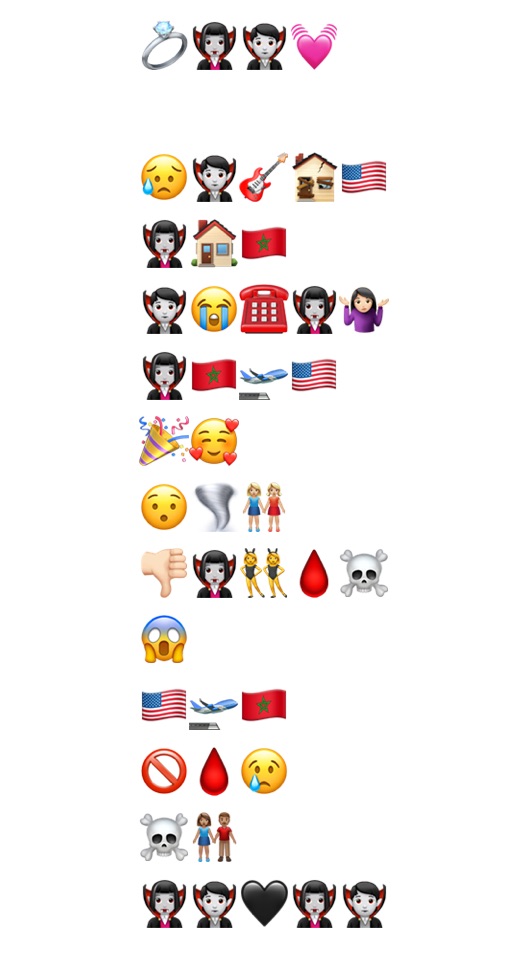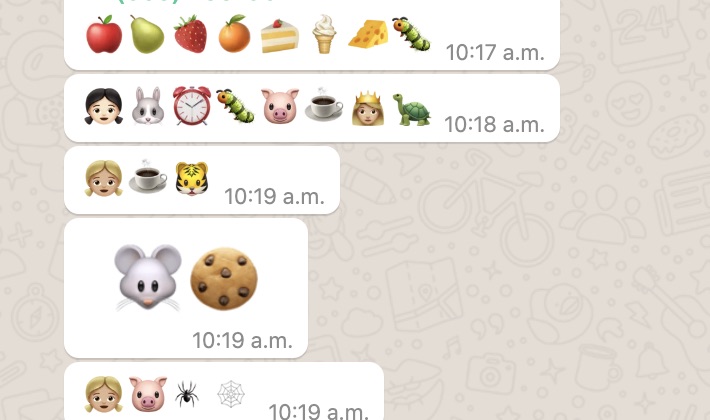
Emoji story based on film
For this emoji story I relied mostly on ideas and words to lay out the plot synopsis of the film I chose. I found that it was easy to represent plot action and basic emotions but was quite difficult to represent relationships between characters. This film does not have a large cast (2 main characters and 3 supporting). Even with the small number of characters it was challenging to represent interactions. A complex plot, or a dialogue driven film would be incredibly difficult. Part of why I chose this story is because it is fairly basic in terms of the romantic story arc and has a distinct feature (vampires) to help the reader decode the reference material. I recently attended a virtual baby-shower and deciphering emoji versions of popular kids books was one of the games. It was pretty fun! My pals and I are all immigrants to the US and each of us is from a different home country (Brazil, Canada, Portugal and Finland). It was interesting to see the slight variations in how we interpret emojis based on our first language.

A new virtual baby shower game is to decipher children’s stories represented by emoji.
My process of “translating” a story to emoji (and I would argue this would have been true of a book or film/show) is akin to what Bolter (Chapter, 4) describes as reverse ekphrasis. The emoji (image) has the task of explaining the text of the source material. I organized the plot into scenes (chapters) and beats (pages). I thought of the story in terms of how it would be represented in a book rather than pulling direct imagery from the film itself. There is so much visual content in a film or show that it would be pages and pages of emojis to directly translate. In essence, I translated a synopsis (a rudimentary ekphrasis itself) rather than each visual cut of the film. In fact I found myself referring occasionally to an IMDB synopsis to ensure I had captured the significant plot points accurately.
Bolter describes new media picture writing as combining both pre-literate (telling a story through time using images) and post-literate (using images as natural signifiers for objects or instructions across language divides). I think this describes the emoji story really well, it was a bizarre experience to simultaneously represent a story arc through time/space and to symbolize objects/ instructions. I think that Bolter slightly missed the mark on how ASCII emoticons would evolve into emoji and how they are used in online writing. He argues that new media writers are moving away from authoritative prose and want to give their work the immediacy of a singular persona. I had to chuckle at the idea that people would abandon writing in favour of sending asynchronous video messages. Even leaving a voicemail message is considered bad taste these days. The reality is that in text based new media forms the writing has more in common with oral rhetoric and conversation than written prose. The emoji functions as a way to return oral modes of emphasis using non-verbal cues such as pacing, expression, breath, and gesture.
Bolter, J. D. (2001). Writing space: Computers, hypertext, and the remediation of print (2nd ed.). Mahwah, N.J: Lawrence Erlbaum Associates